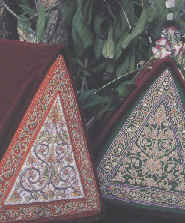| Embroidery in Siam
Ballads that are
normally used in the accompaniment of traditional Thai dance as the prelude to stage
performances normally direct their primary attention to the beautiful and delicate attire
of the performers. This very cultural manifestation reveals much about the attitude of the
Thai people towards the way they dress themselves.
 Traditionally, Thai people wove their own cloth,
color-eyed it and decorated it with exquisite designs. Embroidery is another way they used
to embellish their cloth. Traditionally, Thai people wove their own cloth,
color-eyed it and decorated it with exquisite designs. Embroidery is another way they used
to embellish their cloth.
Because embroidery is
a very fine craft, it requires a lot of time to create a piece of cloth with exquisite
designs. For such a piece of embroidery, therefore, it implies that the cloth is
designated for a very specific purpose, a special occasion, an important person or an
exceptional case. Sometime, an embroidered design telling a story is used as a home
decorative item : Nang Wanthong, is one of the Thai literatures, Khun Chang , Khun Phaen,
also created such a piece of embroidery for the same purpose.
The cloth
used to wrap the Buddhist scriptures, and the ecclesiastic fan containing refined stitches
of embroidery presented to monks at an auspicious merit-making occasion such as an
anniversary merit-making ceremony are examples of embroidery created for specific purpose.
purpose.
Embroidered
works for important people can be seen in those used by members of the Royal family, These
embroidered cloths are normally rare pieces of work. especially the shawls used by court
ladies, which are embroidered using gold and silver threads. And more than just a matter
of aesthetics, they were occasionally gifts given to members of the Royal family as a sign
of official ranking.
These exquisite
designs would be quickly reproduced as costumes for traditional Thai stage performances
featuring stories of the royal court. Authors of these “plays” normally devote part of
the narratives to the exquisite details of the costume almost every time the “star”
appears with the costume in a main scene. As already described, the dancer will dance to
the lyrics of the song or ballads such as “Chom Talad” (visiting the market” or
“Song Thon.”
Embroidery is purely
a feminine thing. Court ladies, for instance, were taught the arts of cooking, floral
arrangement and embroidery, a value similar to that of the contemporaries who send their
children to ballet or piano classes. Except in cases where those doing the embroideries
are capable of creating their own designs, designs for embroidery are normally handled
specifically by designers.
Materials used in
embroidery vary. Some of the major materials such as silver and gold threads, sequins and
beads were once so rare that they had to be imported from countries like Persia and India.
However, some people, because of their artistic inclination, develop their own materials
using things readily available from their surrounding like peek malang tab (bupestris
wings ) and colorful gemstones.
The process of
embroidery starts with the design on a piece of paper. Once this is done, color chalk is
used to trace the design before the chalked traces are transferred onto the cloth. The
stitching then starts following the design on the cloth using, in combination of threads,
materials such as sequins.
|
















![]()